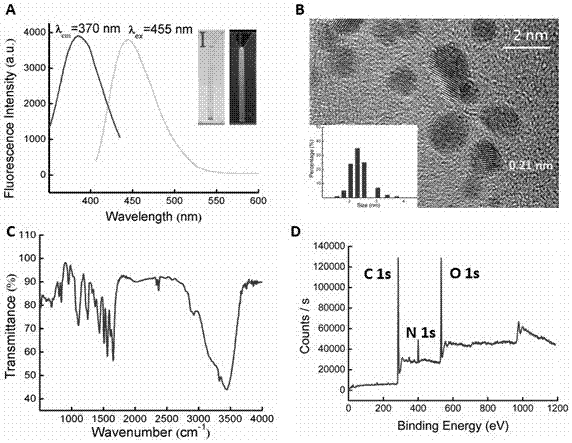Method for preparing carbon dot from mushroom and carbon dot prepared by using method and application
A technology of carbon dots and mushrooms, which is applied in the field of preparation of luminescent materials, can solve the problems that have not yet been seen, and achieve the effects of good fluorescence performance, good application prospect and good biocompatibility.
- Summary
- Abstract
- Description
- Claims
- Application Information
AI Technical Summary
Problems solved by technology
Method used
Image
Examples
Embodiment 1
[0026] Example 1. Preparation of carbon dots with mushrooms as carbon source
[0027] 1. Preparation of carbon dots
[0028] Such as figure 1 As shown, fresh mushrooms were dried at 80°C for 24 hours, and then ground into powder with a mortar; take 0.6 g of mushroom powder, add 6 mL of ultrapure water, mix well, put in a 25 mL polytetrafluoroethylene stainless steel reaction kettle, 200 React at ℃ for 6 hours; cool the resulting reaction solution to room temperature, centrifuge at 10,000 rpm for 15 minutes, collect the supernatant, filter it with a microporous membrane with a pore size of 0.22 μm, and dialyze the filtrate with a dialysis bag with a molecular weight cut-off (MWCO) of 100 for 24 hours Afterwards, freeze-dry to obtain carbon dot powder; disperse the carbon dot powder with ultrapure water to obtain a 1 μg / mL carbon dot dispersion, and store at 4°C.
[0029] 2. Characterization of carbon dots
[0030] The optimal excitation wavelength of carbon dots is 370 nm, a...
Embodiment 2
[0045] Example 2, optimization of conditions for preparing carbon dots with mushrooms as carbon source
[0046] 1. Response time optimization
[0047] According to the method described in Example 1, carbon dots were prepared by reacting at 200° C. for 4, 5, 6, 7, 8, and 9 hours, respectively. The result is as Figure 8 As shown in A, the fluorescence effect of carbon dots prepared by reacting for 5-7 hours is better, and the best reaction time is 6 hours.
[0048] 2. Reaction temperature optimization
[0049] According to the method described in Example 1, carbon dots were prepared by reacting at 120, 140, 160, 180, and 200° C. for 6 hours, respectively. The result is as Figure 8 As shown in B, the fluorescence effect of the carbon dots prepared by the reaction at 180-200°C is better, and the best reaction temperature is 200°C.
Embodiment 3
[0050] Example 3. Application of carbon dots prepared from mushrooms as a carbon source in cell imaging
[0051] Inoculate human lung adenocarcinoma cells (A549 cells) into 6 wells of a 96-well plate, add blocking solution to each well, put them in a wet box, and then put them in a 37°C, 5% CO 2 Incubate in the incubator for 30 minutes, take out the 96 microwell plate, first wash off the blocking solution with 0.01mol / L phosphate buffer solution, then use filter paper to dry up the liquid around the orifice plate, and the carbon dot dispersion prepared in Example 1 with A549 cells in 6 wells at 37°C, 5% CO 2 Incubate for 1 hour in the incubator, wash with 0.01mol / L phosphate buffer, and then observe the labeling of the cells under a fluorescence microscope.
[0052] The results of carbon dot labeling of A549 cells are as follows: Figure 9 As shown, it can be seen that A549 cells exhibit obvious green fluorescence under a fluorescent microscope, indicating that the carbon do...
PUM
| Property | Measurement | Unit |
|---|---|---|
| diameter | aaaaa | aaaaa |
Abstract
Description
Claims
Application Information
 Login to View More
Login to View More - R&D Engineer
- R&D Manager
- IP Professional
- Industry Leading Data Capabilities
- Powerful AI technology
- Patent DNA Extraction
Browse by: Latest US Patents, China's latest patents, Technical Efficacy Thesaurus, Application Domain, Technology Topic, Popular Technical Reports.
© 2024 PatSnap. All rights reserved.Legal|Privacy policy|Modern Slavery Act Transparency Statement|Sitemap|About US| Contact US: help@patsnap.com










